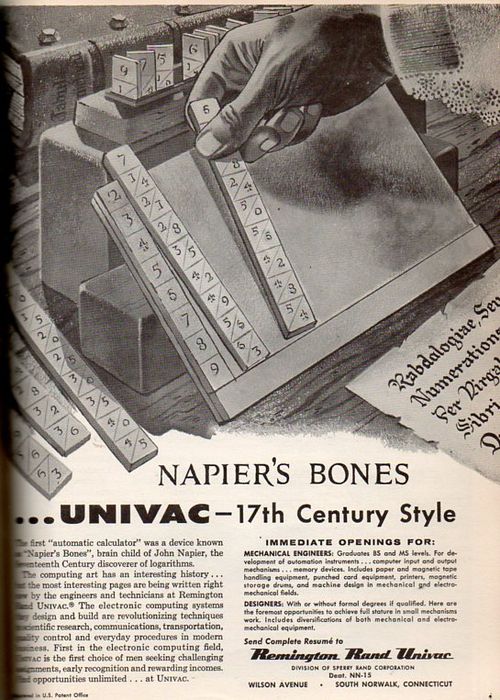JF Ptak Science Books Post 1710
Well, probably. The ad is by UNIVAC—fives years old at this point—and the lace-cuffed image pushing the virtues of the world's first commercial computer is that of John Napier's abacus, which he wrote about in 1617. The ivory calculating bones/rods method had been seen before in the history of the maths and calculation, but not published, and the idea employed in the elegant calculating device were very old, but Napier seems to have gotten to publish it first. (His work on logarithms is of tremendous importance, far more so than the abacus.)
The word “rabdologia” belongs to the title of Napier's significant book (where the title is the abstract): Rabdologia, or, The art of numbring by rods : whereby the tedious operations of multiplication, and division, and of extraction of roots, both square and cubick, are avoided, being for the most part performed by addition and subtraction : with many examples for the practice of the same ...
And I just want to say that since this ad was UNIVAC and it appeared in the November 1956 issue of the early computer journal, Computers and Automation, that the illustration got the “bones” correct. That is, the calculated product is correct.
The way these rods worked is as follows: in the illustration, the number rod on the extreme left (ranging from 2 to 9) is the multiplier; and the numbers at the top of the other rods represented the multiplicand. So we see that the lace-cuff is multiplying the number “76” (at the top of the two rods to the right) by, say, 7. Simply start writing the answer as follows: take the “2” from the 6 rod for your ending number; then add the numbers on the diagonal directly to the left of the two (4+9=13) and take the 3 and place it next to the two in the tens column, and carry the 1 to the next function, which would be 4+1=5. So the answer: 532. The bones could do more than this, of course, but for right now I'd just like to point out that the ad folks got this right--plus its nice to see a bunch of numbers used in public display that actually mean something. [See the Wolfram site for a nice explanation of how the bones work.)
John Napier's work in logarithms (published three years earlier in 1614) is the work for all time; the Rabdologia however would have been instantly appreciated by people like his father, who was master of the mint of Scotland. That said, I've read here and there that Napier considered his most significant published work to be his A Plaine Discovery of the Whole Revelation of St. John (1593), in which he practiced a theo-chronometry based in the Book of Revelation that among other things in its 300-pages predicted that the world would come to an end in 1688. Or 1700. He evidently considered himself a Theologian first and foremost, and what bothered him most was Pope Clement VIII, who he considered to tbe the anti-Christ--and so complications arose. Win two, lose one.
[I've just uploaded Tompkin's classic/first textbook on the digital computer (High Speed Computing), 1950, to the books for sale section of this blog, here.]




Comments